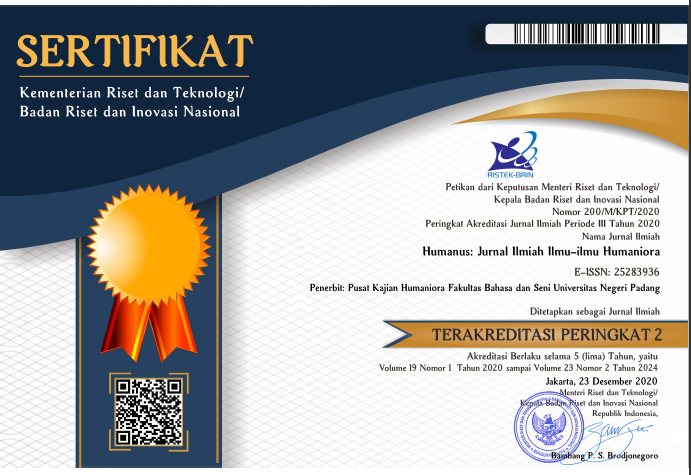The Impact of Larung Sesaji Traditional Culture Modification in Tambakrejo Village
 ), Nur Hadi(3),
), Nur Hadi(3), (1) Universitas Negeri Malang
(2) Universitas Negeri Malang
(3) Universitas Negeri Malang
 Corresponding Author
Corresponding Author
Copyright (c) 2022 Humanus
DOI : https://doi.org/10.24036/humanus.v21i1.113813
Full Text:
 Language : en
Language : en
Abstract
Degraded existence of a tradition is due to 3 (three) main factors: inadequate knowledge on objective and meaning of tradition, inadequate contribution of community and lack of novelty in tradition. Considering such conditions, the author tries to raise the change and the impact of tradition on community life. The author used qualitative method with ethnographic research approach. Techniques of collecting data used were observation, interview, and documentation. The result of research shows the implementation process and the objective of tradition to document culture in order to be preserved in the future. Meanwhile, technique of analyzing used in this research is social construction perspective suggested by Peter L Berger &Luckmann to explain data found. The finding of research indicates that tradition changes with time and affects Tambakrejo people. Public participation is needed to maintain the tradition sustainability. Therefore, to preserve larung sesaji tradition, good human resource, innovation, and creativity are required to face the challenge of tradition existence in the future.
Keywords
References
Akhir, Tugas. 2011. “Wisata Pantai Serang Di Blitar.”
Andriado, Ifan, Hamida Zama Rahmatillah, Anis Khoirun Nisa, and Joan Hesti Gita Purwasih. 2021. “Corona Wedi Buto: Myth in The Efforts of The Tanggulwelahan Villager Facing Covid-19.” Randwick International of Social Science Journal 2(2):75–85. doi: 10.47175/rissj.v2i2.217.
Anggraini, Irene. 2013. “Sikap Masyarakat Surabaya Terhadap Pesan Mistik Dalam Program Acara Dua Dunia Di Trans 7.” E-Komunikasi 1(1):1–12.
Barlian, Eri. 2018. “METODOLOGI PENELITIAN KUALITATIF & KUANTITATIF.” doi: 10.31227/osf.io/aucjd.
Ermiwati. 2019. “MENARA Ilmu Vol. XIII No.2 Januari 2019.” Menara Ilmu XIII(2):102–14.
Hafiz, Gustiawan. abdul, and Waluyo. Joko. 2014. “Strategi Pemerintah Indonesia Dalam Meningkatkan Industri Pariwisata Indonesia Melalui.” Online Mahasiswa 1(1):1–15.
Kurniati, Ni Made Taganing, Everett L. Worthington, Elizabeth Kristi Poerwandari, Adriana S. Ginanjar, and Carissa Dwiwardani. 2017. “Forgiveness in Javanese Collective Culture: The Relationship between Rumination, Harmonious Value, Decisional Forgiveness and Emotional Forgiveness.” Asian Journal of Social Psychology 20(2):113–27. doi: 10.1111/ajsp.12173.
Latifa, Ainul. 2015. “Digital Repository Universitas Jember.” 27.
Ma’ruf, and Abdur Rasyid. 2019. “Nilai-Nilai Pendidikan Islam Dalam Tradisi Belalek.” 1–97.
Mulyana, Ahmad. 2017. “Sekaten Tradition: The Ritual Ceremony in Yogyakarta as Acculturation Reality of Javanese Culture in Indonesia.” International Journal of Humanities & Social Science Studies (IJHSSS) 4(2):50. doi: 10.29032/ijhsss.v4.i2.2017.50-61.
Nahak, Hildgardis M. .. 2019. “Upaya Melestarikan Budaya Indonesia Di Era Globalisasi.” Jurnal Sosiologi Nusantara 5(1):65–76. doi: 10.33369/jsn.5.1.65-76.
Nugraheni, Gendis Wedar, and Ida Bagus Suryawan. 2018. “Dampak Perkembangan Pariwisata Pantai Tambakrejo Terhadap Ekonomi Masyarakat Desa Tambakrejo Kabupaten Blitar.” Jurnal Destinasi Pariwisata 6(1):40. doi: 10.24843/jdepar.2018.v06.i01.p07.
Rijali, Ahmad. 2019. “Analisis Data Kualitatif.” Alhadharah: Jurnal Ilmu Dakwah 17(33):81. doi: 10.18592/alhadharah.v17i33.2374.
Rohimah, Ira Siti, Achmad Hufad, and Wilodati. 2019. “Analisa Penyebab Hilangnya Tradisi Rarangkén ( Studi Fenomenologi Pada Masyarakat Kampung Cikantrieun Desa Wangunjaya ).” Indonesian Journal Of Sociology, Education, and Development 1(1):15–23.
Romadhon, Dicky Reza. 2013. “Menelisik Nilai – Nilai Kearifan Lokal Dalam Upacara Tradisi Larung Sesaji Di Telaga Sarangan Desa Sarangan Kecamatan Plaosan Kabupaten Magetan.” (9):1–19. doi: 10.1017/CBO9781107415324.004.
Rumahuru, Yance Z. 2018. “Ritual Sebagai Media Konstruksi Identitas : Suatu Perspektif Teoretisi.” Dialektika 11(01):22–30.
Sulaiman, Aimie. 2016. “Memahami Teori Konstruksi Sosial Peter L. Berger.” Society 4(1):15–22. doi: 10.33019/society.v4i1.32.
Suparno, Geri Alfikar, Dominika Santi, Veronika Yosi. 2018. “GAWAI DAYAK SINTANG STKIP Persada Khatulistiwa Sintang A . Pendahuluan Kebudayaan Memegang Peranan Yang Sangat Penting Dalam Kehidupan Sebagaimana Yang Kita Sebuah Kelompok Masyarakat Lokal ( Ajawaila , 2011 ). Budaya Lokal Di Indonesia Ini Sangatlah Bera.” 3(1):43–56.
Utami, Niken Wahyu, Suminto A. Sayuti, and Jailani. 2019. “Math and Mate in Javanese Primbon: Ethnomathematics Study.” Journal on Mathematics Education 10(3):341–56. doi: 10.22342/jme.10.3.7611.341-356.
Varnum, Michael E. W., and Igor Grossmann. 2017. “Cultural Change: The How and the Why.” Perspectives on Psychological Science 12(6):956–72. doi: 10.1177/1745691617699971.
Whelan, Chad. 2016. “Organisational Culture and Cultural Change: A Network Perspective.” Australian and New Zealand Journal of Criminology 49(4):583–99. doi: 10.1177/0004865815604196.
Windiani, and Farida Nurul. 2016. “Menggunakan Metode Etnografi Dalam Penelitian Sosial.” Dimensi Jurnal Sosiologi 9(2):87–92.
 Article Metrics
Article Metrics
 Abstract Views : 553 times
Abstract Views : 553 times
 PDF Downloaded : 124 times
PDF Downloaded : 124 times
Refbacks
- There are currently no refbacks.
Copyright (c) 2022 Humanus

This work is licensed under a Creative Commons Attribution-NonCommercial 4.0 International License.










